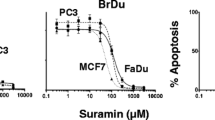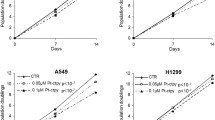Abstract
Purpose. We recently demonstrated simultaneous targeting of telomere and telomerase as a novel cancer therapeutic approach, and that telomerase inhibitors such as 3′azido-3′deoxythymidine (AZT) significantly enhanced the antitumor activity of paclitaxel, which causes telomere erosion, in telomerase-positive human pharynx FaDu tumors in vitro and in vivo (1). The present study evaluated the synergy between AZT and paclitaxel to identify optimal combinations for future clinical evaluation.
Methods. FaDu cells were incubated with or without AZT for 24 h and then treated with AZT with or without paclitaxel for an additional 48 h. Under these conditions, single agent paclitaxel produced a 60% maximum reduction of cell number (IC50 was 7.3 nM), and single agent AZT produced a 97% reduction (IC50 was 5.6 μM). Synergy was evaluated using fixed-concentration and fixed-ratio methods, and data were analyzed by the combination index method.
Results. The results indicate a concentration-dependent synergy between the two drugs; the synergy was higher for combinations containing greater paclitaxel-to-AZT concentration ratios and increased with the level of drug effect. For example, in combinations containing 1 μM AZT, synergy was 1.3-fold at the 20% effect level and 3.1-fold at the 60% effect level. Because the major antitumor activity, determined by comparing the posttreatment cell number to the pretreatment cell number, was antiproliferation at the 20% effect level and cell kill at the 60% effect level, our results suggest that AZT mainly enhances the cell kill effect of paclitaxel.
Conclusion. In summary, the present study demonstrates a synergistic interaction between paclitaxel and AZT and supports a combination using a low and nontoxic AZT dose in combination with a therapeutically active dose of paclitaxel.
Similar content being viewed by others
REFERENCES
Y. Mo, Y. Gan, S. Song, J. Johnston, X. Xiao, M. G. Wientjes, and J. L.-S. Au. Simultaneous targetting of telomeres and telomerase as a cancer therapeutic approach. Cancer Res. 63:579–585 (2003).
V. A. Zakian. Telomeres: beginning to understand the end. Science 270:1601–1607 (1995).
W. Fu, J. G. Begley, M. W. Killen, and M. P. Mattson. Anti-apoptotic role of telomerase in pheochromocytoma cells. J. Biol. Chem. 274:7264–7271 (1999).
V. Urquidi, D. Tarin, and S. Goodison. Role of telomerase in cell senescence and oncogenesis. Annu. Rev. Med. 51:65–79 (2000).
C. I. Nugent, G. Bosco, L. O. Ross, S. K. Evans, A. P. Salinger, J. K. Moore, J. E. Haber, and V. Lundblad. Telomere maintenance is dependent on activities required for end repair of double-strand breaks. Curr. Biol. 8:657–660 (1998).
T. Ishikawa, M. Kamiyama, H. Hisatomi, Y. Ichikawa, N. Momiyama, Y. Hamaguchi, S. Hasegawa, T. Narita, and H. Shimada. Telomerase enzyme activity and RNA expression in adriamycin-resistant human breast carcinoma MCF-7 cells. Cancer Lett. 141:187–194 (1999).
N. W. Kim, M. A. Piatyszek, K. R. Prowse, C. B. Harley, M. D. West, P. L. Ho, G. M. Coviello, W. E. Wright, S. L. Weinrich, and J. W. Shay. Specific association of human telomerase activity with immortal cells and cancer. Science 266:2011–2015 (1994).
J. Feng, W. D. Funk, S. S. Wang, S. L. Weinrich, A. A. Avilion, C. P. Chiu, R. R. Adams, E. Chang, R. C. Allsopp, and J. Yu. The RNA component of human telomerase. Science 269:1236–1241 (1995).
T. M. Bryan, A. Englezou, L. Dalla-Pozza, M. A. Dunham, and R. R. Reddel. Evidence for an alternative mechanism for maintaining telomere length in human tumors and tumor-derived cell lines. Nature Med. 3:1271–1274 (1997).
C. Strahl and E. H. Blackburn. Effects of reverse transcriptase inhibitors on telomere length and telomerase activity in two immortalized human cell lines. Mol. Cell. Biol. 16:53–65 (1996).
P. Skehan, R. Storeng, D. Scudiero, A. Monks, J. McMahon, D. Vistica, J. T. Warren, H. Bokesch, S. Kenney, and M. R. Boyd. New colorimetric cytotoxicity assay for anticancer-drug screening. J. Natl. Cancer Inst. 82:1107–1112 (1990).
M. C. Berenbaum. What is synergy? Pharmacol. Rev. 41:93–141 (1989).
T. C. Chou and P. Talalay. Quantitative analysis of dose–effect relationships: the combined effects of multiple drugs or enzyme inhibitors. Adv. Enzyme Regul. 22:27–55 (1984).
W. C. Hahn, S. A. Stewart, M. W. Brooks, S. G. York, E. Eaton, A. Kurachi, R. L. Beijersbergen, J. H. Knoll, M. Meyerson, and R. A. Weinberg. Inhibition of telomerase limits the growth of human cancer cells. Nature Med. 5:1164–1170 (1999).
Y. Kondo, S. Kondo, Y. Tanaka, T. Haqqi, B. P. Barna, and J. K. Cowell. Inhibition of telomerase increases the susceptibility of human malignant glioblastoma cells to cisplatin-induced apoptosis. Oncogene 16:2243–2248 (1998).
B. Herbert, A. E. Pitts, S. I. Baker, S. E. Hamilton, W. E. Wright, J. W. Shay, and D. R. Corey. Inhibition of human telomerase in immortal human cells leads to progressive telomere shortening and cell death. Proc. Natl. Acad. Sci. USA 96:14276–14281 (1999).
S. E. Holt, V. V. Glinsky, A. B. Ivanova, and G. V. Glinsky. Resistance to apoptosis in human cells conferred by telomerase function and telomere stability. Mol. Carcinogen. 25:241–248 (1999).
X. Zhang, V. Mar, W. Zhou, L. Harrington, and M. O. Robinson. Telomere shortening and apoptosis in telomerase-inhibited human tumor cells. Genes Dev. 13:2388–2399 (1999).
W. Fu, J. G. Begley, M. W. Killen, and M. P. Mattson. Anti-apoptotic role of telomerase in pheochromocytoma cells. J. Biol. Chem. 274:7264–7271 (1999).
S. Kondo, Y. Tanaka, Y. Kondo, M. Hitomi, G. H. Barnett, Y. Ishizaka, J. Liu, T. Haqqi, A. Nishiyama, B. Villeponteau, J. K. Cowell, and B. P. Barna. Antisense telomerase treatment: induction of two distinct pathways, apoptosis and differentiation. FASEB J. 12:801–811 (1998).
J. G. Ren, H. L. Xia, T. Just, and Y. R. Dai. Hydroxyl radical-induced apoptosis in human tumor cells is associated with telomere shortening but not telomerase inhibition and caspase activation. FEBS Lett. 488:123–132 (2001).-
C. Strahl and E. H. Blackburn. Effects of reverse transcriptase inhibitors on telomere length and telomerase activity in two immortalized human cell lines. Mol. Cell. Biol. 16:53–65 (1996).
S. M. Melana, J. F. Holland, and B. G. Pogo. Inhibition of cell growth and telomerase activity of breast cancer cells in vitro by 3′-azido-3′-deoxythymidine. Clin. Cancer Res. 4:693–696 (1998).
A. Mazumder, D. Cooney, R. Agbaria, M. Gupta, and Y. Pommier. Inhibition of human immunodeficiency virus type 1 integrase by 3′-azido-3′-deoxythymidylate. Proc. Natl. Acad. Sci. USA 91:5771–5775 (1994).
W. Lewis and M. C. Dalakas. Mitochondrial toxicity of antiviral drugs. Nature Med. 1:417–422 (1995).
B. Jacobsson, S. Britton, Q. He, A. Karlsson, and S. Eriksson. Decreased thymidine kinase levels in peripheral blood cells from HIV-seropositive individuals: implications for zidovudine metabolism. AIDS Res. Hum. Retroviruses 11:805–811 (1995).
O. A. Olivero and M. C. Poirier. Preferential incorporation of 3′-azido-2′,3′-dideoxythymidine into telomeric DNA and Z-DNA-containing regions of Chinese hamster ovary cells. Mol. Carcinogen. 8:81–88 (1993).
B. Chandrasekaran, T. E. Kute, and D. S. Duch. Synchronization of cells in the S phase of the cell cycle by 3′-azido-3′-deoxythymidine: implications for cell cytotoxicity. Cancer Chemother. Pharmacol. 35:489–495 (1995).
M. D. Mediavilla and E. J. Sanchez-Barcelo. Doses and time-dependent effects of 3′-azido-3′-deoxythymidine on T47D human breast cancer cells in vitro. Pharmacol. Toxicol. 87:138–143 (2000).
M. Roskrow and S. N. Wickramasinghe. Acute effects of 3′-azido-3′-deoxythymidine on the cell cycle of HL60 cells. Clin. Lab. Haematol. 12:177–184 (1990).
Author information
Authors and Affiliations
Corresponding author
Rights and permissions
About this article
Cite this article
Johnston, J.S., Johnson, A., Gan, Y. et al. Synergy Between 3′Azido-3′deoxythymidine and Paclitaxel in Human Pharynx FaDu Cells. Pharm Res 20, 957–961 (2003). https://doi.org/10.1023/A:1024431218327
Issue Date:
DOI: https://doi.org/10.1023/A:1024431218327




